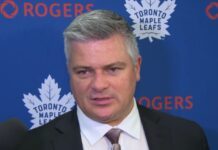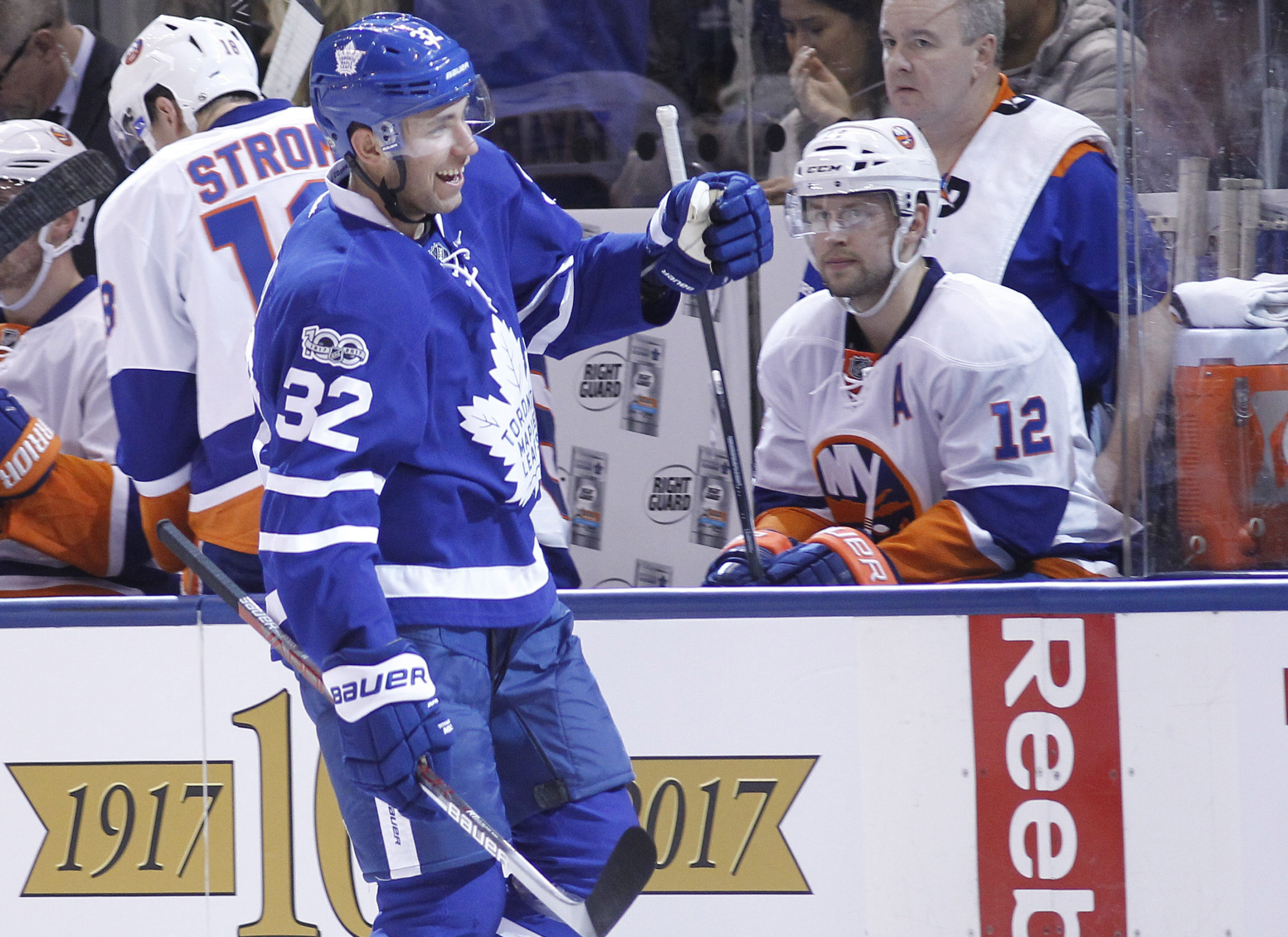Josh Leivo enters his fifth professional season with the organization facing another tough battle for big-club opportunity and ice time.
The 24-year-old’s 2016-17 season was similar to his previous NHL season, except he was forced to ply his trade in practice with the Leafs — for the most part — rather than with the Toronto Marlies due to waiver considerations. He again dressed for only a dozen NHL games, yet he was quite productive when he played.
2016-17 Season Summary
A scratch for the first 30 games of the season, Leivo finally received something resembling an extended opportunity in the month of February when Nikita Soshnikov went down hurt for the first time. Playing on a line with Matt Martin and Ben Smith, he made an impact in a 7-1 blowout win against the Islanders: Leivo sniped the 1-0 goal, added an assist on an Auston Matthews goal on the power play, and grabbed another assist on a Matt Hunwick goal in garbage time for his first career three-point game, earned in just 9:48 of ice time.
In the following game, after the Leafs fell behind 4-0 against Columbus by the midway point of the contest, Babcock shook up his lines (Mitch Marner also left the game injured) and elevated Leivo onto Kadri’s wing. He helped set up two Kadri goals in the span of nine minutes late in the second and early in the third period.
With Connor Brown shifting down onto a line with Tyler Bozak and JVR due to Marner’s injury, Leivo joined Nazem Kadri and Leo Komarov for a full game against Ottawa and picked up another assist on a Kadri goal. Two games later came Leivo’s third multi-point effort in the span of five games after collecting two primary assists on goals by Komarov and Kadri against the Jets.
During his only consistent look in February, Leivo played with a tonne of urgency on the forecheck and in his battles down low and looked to have added a step to his skating compared to years previous. He piled up nine points in a 10-game stretch and appeared to have earned an extended stay in the lineup heading down the stretch.
That wasn’t how it played out. When the Leafs were fully healthy again and added Brian Boyle just before the deadline, Leivo played one game next to Boyle and Martin on the fourth line against San Jose. Mike Babcock didn’t like the mix, and in the second game of the Leafs’ winless California road trip, Soshnikov re-entered the lineup against the Kings while Leivo returned to the press box.
Leivo was left twisting in the wind again. Hesitant to turn to some of his more skilled forwards (such as a Mitch Marner) in shorthanded situations, Babcock felt his fourth-line right winger needed to be able to serve on the penalty kill in those crucial games down the stretch, and that Leivo wasn’t an option there.
When Soshnikov went down to injury again in the win against Boston on March 20, Eric Fehr played instead of Leivo versus Columbus because Fehr could fill the void on the penalty kill. After Fehr went down hurt in his first game as a Leaf, Leivo got into one final game against New Jersey on March 23. His last act of the season was, of course, scoring a goal in that game (on the power play).
Leivo picked up an injury that night against the Devils and it spelled the end of his season. The Leafs recalled Kasperi Kapanen from the Marlies on March 27 and the Finnish rookie never looked back. Babcock liked that Kapanen could serve on the PK (a role he excelled in with the Marlies) in addition to the speed he brought to a fourth line with two slower, big-bodied players in Brian Boyle and Matt Martin. It proved to be a shrewd call-up decision, as Kapanen scored key goals against Pittsburgh to clinch a playoff spot and in overtime against Washington in Game 2 of the playoffs.
2016-17 Statistics
| GP | G | A | Pts | PP Points | TOI/g | 5v5 Pts/60 | Shots | Sh% | CF% |
|---|---|---|---|---|---|---|---|---|---|
| 13 | 2 | 8 | 10 | 3 | 12:34 | 3.12 | 27 | 7.4 | 55.3 |
Overall, Leivo tallied two goals and eight assists in 13 games while playing 12:34/game on average — good for a 3.12 points-per-60 at 5v5, which was highest on the team. His 55.3 CF% was the best on the team, including a 57.7% CF in his 72 minutes of even strength ice time on Nazem Kadri’s wing.
Of course, this is all in the context of a limited 12-game sample. The Leafs’ injury luck up front in their top nine forward group didn’t help Leivo’s cause: Among their six regular top nine wingers, Hyman, Komarov, Brown and JVR all played 82 games, Nylander played 81, and Marner played 77. When an injury did occur in the Leafs top nine and Leivo got a look next to Kadri and Komarov, he was highly productive in that role. It’s hard to envision where Leivo fits in the Leafs lineup next season as we head toward camp, but if he sticks around in the press box again to start the year, it’s likely that the team will need to turn to their depth options a little more often in 2017-18.
In addition to the health factor, Babcock also left his top nine more or less untouched in terms of line mixing after the Leafs sent Milan Michalek to the minors in October. Brown and William Nylander swapped places on the right wing at different times depending on recent performance and road vs. home matchups, but that was about the extent of it. The pairs of Komarov – Kadri and Hyman – Matthews were etched in stone, as was the JVR – Bozak – Marner line.
We never got a look at Leivo on Auston Matthews’ wing, but it would’ve been interesting to witness that experiment during one of Zach Hyman’s lengthier scoring droughts last season. Leivo prefers his off-wing as a right-hander and has the hands and shot to play there.
2017-18 Outlook
Leivo’s recent interview with the Toronto Sun’s Lance Hornby suggested that the organization was never in doubt about protecting him in the expansion draft and that Leafs brass indicated to him in their April exit meeting that he would be back for 2017 training camp (he was also given the offseason assignment of improving his skating).
Unfortunately for Leivo, the Leafs’ depth chart situation up front has only gotten more complicated and crowded with the Leafs’ addition of veteran scorer Patrick Marleau while returning all of their top nine forwards from last year as of this writing.
Theoretically, the addition of centerman Dominic Moore in Brian Boyle’s spot improves the pace of the fourth line and shifts the dynamic of the unit a little bit, so it’s possible Babcock sees Leivo as a better fit on the fourth line wing this season than he did last. Even then, with Marleau added, Leivo would have to unseat one of Zach Hyman (not happening) or Matt Martin for a spot in the lineup, with added competition from Kasperi Kapanen (who has higher upside and appears ready for full-time NHL duty) and Nikita Soshnikov, in addition to any potential dark horses making a push from the Marlies. And there is the issue of Leivo having little professional experience on the penalty kill, unlike Hyman, Kapanen and Soshnikov.
It’s worth mentioning here, as the Leafs face ongoing questions about JVR’s future (trade him, sign him, or use him for a year and let him walk?): Leivo isn’t going to replace JVR’s production, but he does provide scoring touch, size and skill down low, potentially a net-front presence on the power play, and the ability to play both wings. The Leafs have held onto Leivo has long as they have because he brings skill and a unique package to the table, and it’s something they might miss if they lose both Leivo and JVR in the next year.
Leivo is a player with everything to play for in training camp and – entering a contract year and waiver eligible — the clock is ticking on his opportunity stake a claim to a spot in the Leafs lineup. Unfortunately, the numbers game is stacked pretty strongly against him as things currently stand. But if he shows up in great shape and makes an impact in camp, the Leafs could have a (good) problem to sort out before opening day.
Up tomorrow in the player preview series: Zach Hyman


































